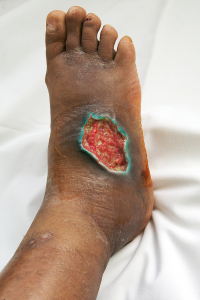Generally speaking, patients with diabetes have a high complication rate with ankle fractures and foot problems. Moreover, diabetes causes peripheral neuropathy, which can lead to numbness in feet.
Given these points, there is a silent change of the vascular supply in both feet, which leads to peripheral vascular disease and wound healing can be more complicated with injuries, fractures or arthritis. For instance, in patients with long standing uncontrolled diabetes the pressure from standing on the feet alone can interfere with normal blood supply and a diabetic foot ulcer may develop.
Neuropathic pain
For the most part neuropathic pain is more common as the nerves of the legs have undergone severe changes with a lack of feeling and a loss of the normal protective reflexes. Overall this often leads to major foot pain and other problems that are extremely difficult to treat.
Generally speaking with ankle fractures in diabetics there is a complication rate of about 40% whereas a control group with non diabetics had none. The complications ranged from osteomyelitis to chronic diabetic foot ulcers to septicemia. For these reasons treatment in diabetics should be very conservative. The physician would utilize mostly non-operative methods as otherwise below knee amputations have to be done in order to rescue a patient who gets complications from what appeared first to be a minor foot or ankle problem (Ref. 3).
More information about diabetes: https://nethealthbook.com/hormones/diabetes/
References
1. ABC of rheumatology, second edition, edited by Michael L. Snaith , M.D., BMJ Books, 1999. Chapter 5.
2. The Merck Manual, 7th edition, by M. H. Beers et al., Whitehouse Station, N.J., 1999. Chapter 270.
3. Wheeless’ Textbook of Orthopaedics: http://www.wheelessonline.com/
4. The Merck Manual, 7th edition, by M. H. Beers et al., Whitehouse Station, N.J., 1999. Chapter 60, p.487.
5. Goldman: Cecil Textbook of Medicine, 21st ed.(©2000)W.B.Saunders
6. Ferri: Ferri’s Clinical Advisor: Instant Diagnosis and Treatment, 2004 ed., Copyright © 2004 Mosby, Inc.
7. Rakel: Conn’s Current Therapy 2004, 56th ed., Copyright © 2004 Elsevier







